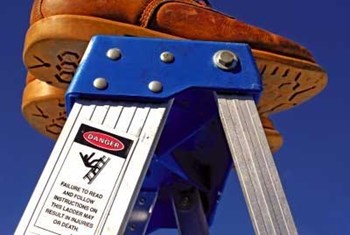
Part of the process of bidding and hiring a contractor to work in your building is verifying their insurance coverage. Uninsured or inadequately insured contractors pose a serious threat to a co-op or condo community’s finances and can cause huge legal headaches. To avoid exposing a co-op or condo to serious liability and expense, it’s up to boards and managers to thoroughly vet the people they bring in to do even basic maintenance projects in their building.
A Look at the Law
First and foremost, because of state and federal laws and the size and scope of some of the projects being undertaken, residential buildings have tremendous exposure to lawsuits. Even work done inside individual apartments can involve the building if an accident should happen. Even something as seemingly benign as hiring your brother-in-law to paint your bedroom has the potential to wreak havoc on your building’s insurance landscape.
Sections 240(1) and 241(6) of the New York State Labor Law outline the responsibility of both contractors and buildings to create a safe working environment for laborers, particularly those working on scaffolds. Considered pro-worker to a fault by contractors and building owners alike, Labor Law 240/241—and its interpretation by the courts—is “the biggest issue in New York today,” says Alnoor Ladha, executive vice president of Manhattan-based Vanderbilt Properties Insurance Brokerage LLC.
New York’s stringent legislation has long been unpopular with contractors. In testimony to the State Insurance Department five years ago, the Business Council groused that “New York’s courts have upheld this ‘absolute liability standard,’ which means property owners and their contractors have no way to defend their actions and their safety records in liability cases that fall under this statute.”
“The duty to provide proper safety devices to construction workers is non-delegable and absolute, making owners and general contractors vicariously and absolutely liable for worker injuries even if they do not supervise or control the construction work,” says Thomas Hughes, executive vice president, general counsel, and secretary of Greater New York Mutual Insurance Company in Manhattan. “Absolute liability even attaches to fee owners who have leased the land to another and did not own the building itself, and to lessees who hire the contractor.”
Too Tough on Buildings?
“Cooperative corporations are vulnerable under Labor Law 240(1) and 241(6) because they own the buildings,” says Hughes. “The statute specifically makes owners, agents, contractors, and enumerated others liable regardless of fault. Indeed, cooperatives are in the same position as the owner of a rental apartment house or an office or other commercial space. They may be liable for any violation of Labor Law § 240(1) or § 241(6) that proximately causes injury to the plaintiff, regardless of whether it contracted for or benefited from the work in [the shareholder’s] apartment.”
“Condo associations have also been held liable under 240(1) and 241(6),” Hughes continues. “It does not seem to matter that the association does not actually own any real estate. At a minimum, the association’s board manages the property for the owners in general. It would also appear that managing agents (as agents of the owners, a liable party under 240(1)) and 241(6)) would also be held liable under the statute. I would anticipate that the condominium residential unit owner would be protected under 240 claims in the same manner as the co-op tenant.”
“The Scaffolding Law or the Fall-From-Height Law makes it hard for contractors to get coverage in New York State,” Ladha adds, bringing up one of the well-intended law’s potential unintended consequences. This has limited the number of contractors who have the proper insurance coverage—and opened the door for those who don’t.”
“In a lawsuit, nobody cares about negligence,” opines Scott Colosimo, vice president of the Stern Agency, Inc., an insurance brokerage in New City in Rockland County. “They like to throw everything against the wall and see what sticks. A good lawyer will sue everybody.”
The seemingly logical move to make when a worker is negligent or gets injured on the job—legal action against the employer—rarely flies, says Colosimo. “They can’t sue their boss, because that falls under worker’s comp,” he says.
All of this is not to say that a co-op or condo building will ultimately be held liable, or have to pay one cent in damages resulting from a worker’s injury or death on the job, but legal fees are not cheap. And lawsuits can be risky business. “On a certain day, a certain jury, you don’t know how it’s going to turn out,” Colosimo says.
There is some evidence that the courts are backing away from the absolute liability standard, however. According to Ladha, a recent case involving a painter who neglected to wear a harness despite several orders to do so and subsequently fell off the George Washington Bridge found that the employee was partially at fault.
But the lesson is clear: it is exceedingly important to make sure that contractors have the proper paperwork in place before they set foot on your premises.
Covering Bases
So what documents should a contractor have?
First, a so-called hold harmless agreement, indemnifying the building in case something goes awry. “A hold harmless agreement states that if any of the contractor’s employees get hurt on the job, they don’t have the ability to sue the building owner,” says Colosimo.
It’s one thing to have a plumber fix a leak at 2 a.m. without asking for his documents in triplicate beforehand. But contractors working on bigger projects— especially ones that involve any type of heights—are another story.
“When you have guys working outside and stuff like that,” says Edward Mackoul, president of Manhattan-based insurance company Mackoul & Associates, it’s prudent to dot all the i’s and cross all the t’s. Mackoul says that contractors should carry four forms of insurance: general liability, contractual liability, worker’s compensation, and disability.
“We advise that there should not be any time when you deal with a contractor that doesn’t have contractual liability,” says Colosimo, who also recommends liability limits in the millions of dollars.
To ensure that contractors have the requisite coverage, buildings should demand to see certificates of insurance as part of the bidding process, and study these certificates closely.
“Contractors are rated [by insurance companies] based on the scope of their work,” Colosimo. “A roofer has a much higher premium than a plumber.”
He also stresses that the work a contractor’s crew is doing should match the work they’re insured for. “Make sure they’re properly rated as a general contractor,” says Colosimo. “If they’re doing work outside the scope of their business as a contractor, the insurer will deny the claim, no questions asked.”
Some contractors are leery of releasing their coverage information—and the professionals warn that buildings should in turn be very leery of hiring them.
“It’s hard to get a contractor to release their classification,” Colosimo says. The information is private, like medical records, and can only be released with written approval by the contractor. “Contractors who are willing to show you will definitely have the proper coverage in place.”
Another potential pitfall: Contractors may be licensed in New Jersey or Connecticut, but not in New York, where the Labor Law makes insurance premiums significantly higher. Watch out for this tactic, as coverages are state-specific, and if your Connecticut-insured contractor’s worker gets injured in your New York building, you could be on the hook to pay out some very universal money in damages.
What if the contractor forges a certificate of insurance outright? “Report the matter to the fraud bureau of the New York State Department of Insurance, to the insurance company listed in the insurance documents, and—depending upon the situation—to the attorney that represents your building,” advises Hughes. “The best way for a carrier and a general contractor to protect against the possibility of misrepresentation of coverage on the certificate—and it does happen—is to request a copy of the actual policy to make sure that the general contractor’s indemnity obligation is covered and that the building is named as an additional insured on the policy. Indeed, the certificate of insurance specifically states—and New York courts have specifically held—that the certificate alone is not evidence of insurance, and is essentially an informational document only.”
Individual Issues
While co-ops may have slightly higher premiums than condos, there is no major difference between the two with respect to contractor insurance. “Liability’s still the same,” Mackoul says.
One commonality: both tenants and shareholders can expose the building to lawsuits, even if something happens inside an individual unit. “If a tenant or shareholder does not have a good certificate of insurance provided by their contractor,” Ladha warns, “then the tenant or shareholder is exposed—and so is the building.”
This can make even a routine job a headache. “If a resident brings in an ordinary painter, and you lend a stool, and he falls,” Ladha says, “you are held responsible.”
Clearly, a balance must be struck between protecting workers on the job and insuring that negligent or fraudulent contractors don’t leave blameless building communities holding the bag. So what’s to be done?
“The building can request that all tenants or shareholders make sure they have homeowners insurance,” says Ladha. “Make sure contractors have proper worker’s comp and liability coverage.” And, finally, “Make sure there is a contract between residents and contractors.”
The bottom line is that building administrators simply must be very careful about vetting the insurance paperwork of anyone performing work in or on the building. The Labor Law situation has increased the likelihood that some contractors will bend the rules to get work. You don’t know for sure the one you hire is on the up and up—unless you secure the proper documentation in advance.
“There are shady contractors,” Ladha says—and making sure your co-op or condo community isn’t victimized by one is a matter of vigilance and attention to the fine print.
Greg Olear is a freelance writer and a frequent contributor toThe Cooperator.






3 Comments
Leave a Comment